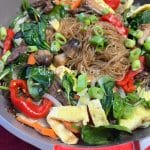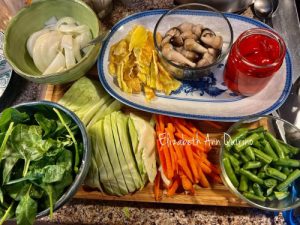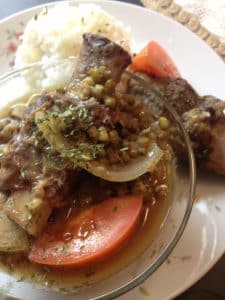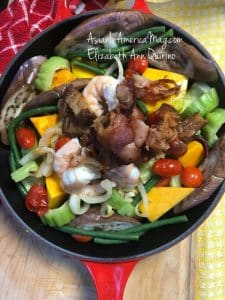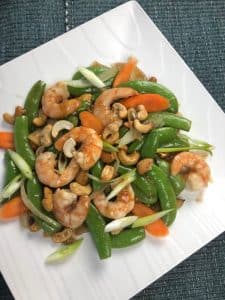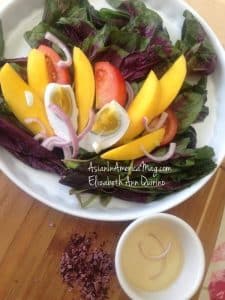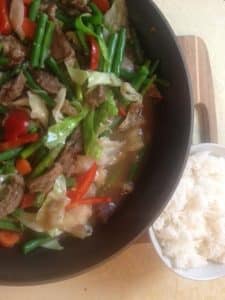Korean Japchae
As an Amazon Associate and member of other affiliate programs, I earn from qualifying purchases.
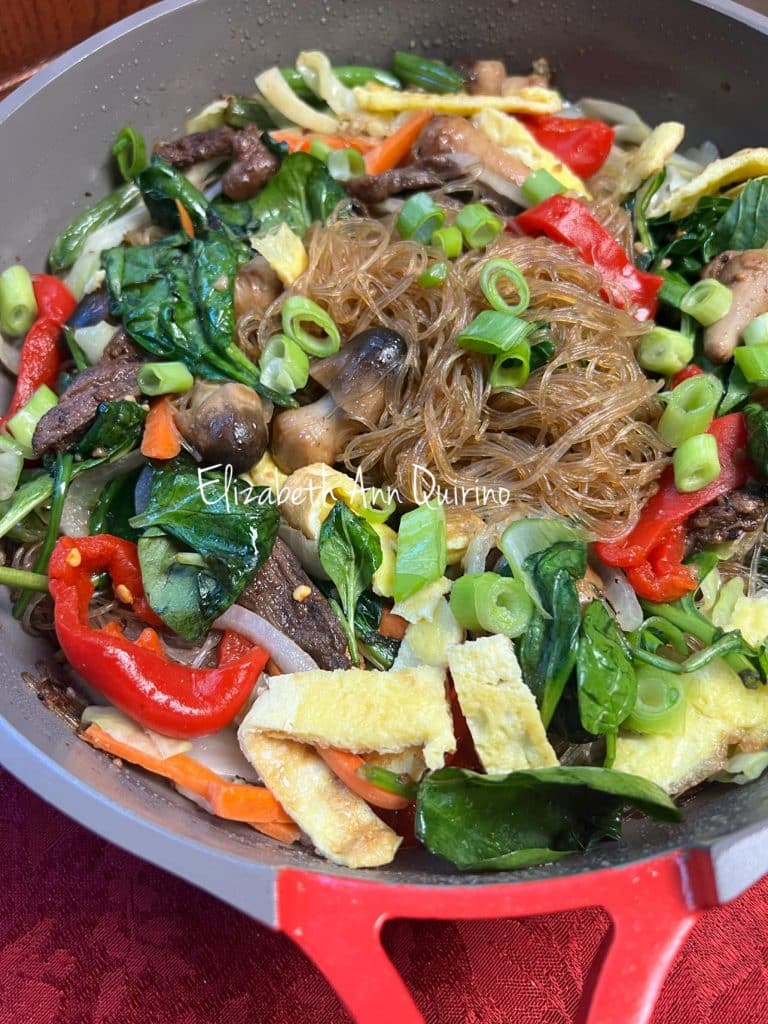
We had been craving Korean Japchae for the longest time. But in the absence of Korean restaurants within a 50-mile radius of our suburban home, I resorted to cooking the dish in my kitchen.
Japchae is a Korean dish which usually has sweet potato starch noodles and assorted vegetables. The word japchae in Korean means mixed vegetables. I sought the advice of a Korean friend nearby on how to cook this popular all-in-one meal. I discovered that it looks quite similar to our Filipino pancit bihon or sotanghon guisado. Like the Filipino counterparts, Korean Japchae is traditionally served during holidays and special occasions.
My Korean friend Joyce suggested I cook the vegetables individually, and then blend them with the noodles at the end. I followed her advice. It wasn’t as daunting as one would imagine. Vegetables cook quickly. And I did it while the cellophane noodles I used pre-soaked in water.
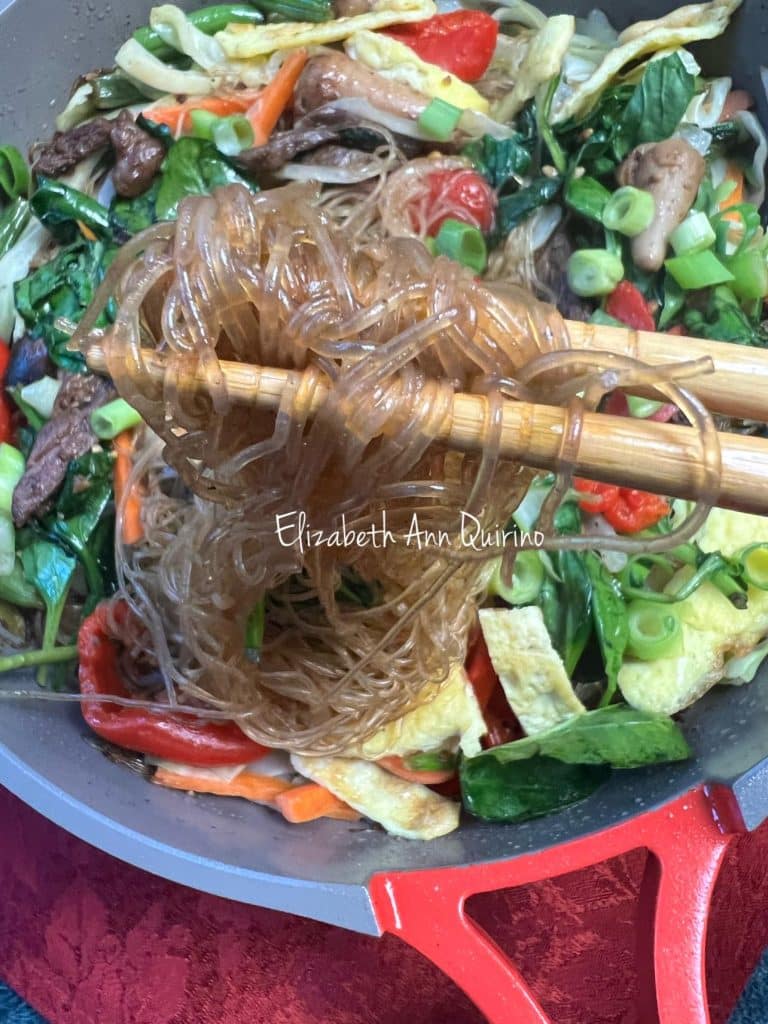
You can make this dish an all-veggies version if you like. Or you can add meat strips like I did. “Use beef slices,” my Korean friend suggested. I sliced beef thinly and did just that. I blanched the spinach, and stir-fried the carrots, bell peppers, cabbage, and mushrooms. Then, it all came together beautifully in the skillet. The long languid clear noodles mixed and merged gently. The clear-colored cellophane noodles transformed to a light brown hue. The sweet aroma of sesame oil defined the dish. I twirled my chopsticks and the noodles wrapped around them, strips of vegetables clinging fast on it. Nothing else is as hearty and comforting as a heaping mountain of Japchae for a meal, any day.
Korean Japchae
Equipment
- Large skillet or Wok: 12 to 14 inches diameter
- Assorted sizes - Mixing Bowls
- chopping board
Ingredients
- 24 ounces cellophane noodles (sotanghon)
- 1 Tablespoon vegetable oil
- 2 whole eggs, beaten
- 250 grams beef strips, sliced thin
- 3 cups baby spinach
- 2 cloves garlic, minced
- 1 whole white or yellow onion, chopped
- 2 stalks scallion whites
- 1 whole medium-sized carrot, peeled, julienne strips
- 1 cup green beans, edges trimmed, sliced in 2-inch pieces
- 3 cups shredded cabbage
- 1 whole red bell pepper, sliced thin, seeded
- 1 cup straw mushrooms, fresh or canned; sliced in halves
- 2 stalks scallion greens, chopped; for garnish
For the sauce:
- 2 Tablespoons thick soy sauce
- 1 Tablespoon oyster sauce
- 2 Tablespoons brown sugar
- 1 Tablespoon honey
- 1 teaspoon sesame oil
- 1 Tablespoon shao xing rice wine
- 1 cup soup stock
- ½ teaspoon ground black pepper
Instructions
To prepare noodles:
- In a bowl filled with water, soak the cellophane noodles for 20 minutes. Do not soak longer than this time or noodles will get mushy. After 20 minutes, drain and discard water. Set the softened noodles aside.
To cook the egg omelet:
- In a small bowl, beat the eggs till fluffy, for about 2 minutes.In the skillet, over medium heat, pour the oil. When oil is hot enough, pour the beaten eggs all around to make a round omelet. Eggs start to solidify. When eggs become an omelet in about 7 to 10 minutes, using a turner, transfer the omelet to a plate. Slice the omelet in 2-inch strips. Set aside.
To prepare and cook the beef and vegetables:
- In a medium-sized stockpot, over medium-high heat, pour enough water to submerge the spinach. When water starts to boil, blanch the spinach for 20 seconds. Using a small colander or slotted spoon, remove the spinach leaves immediately. Set aside in a small bowl.
- Using the same skillet with the same oil, over medium heat, add the beef strips. Braise the beef strips for 5 to 6 minutes till meat is brown. Do not overcook or beef gets tough.Using a slotted spoon, remove and set aside the beef strips.
- Using the same skillet, over medium heat, saute the garlic, onions and scallion whites for 2 minutes till fragrant.Add the carrots and stir fry for 3 minutes. Using a slotted spoon, remove the carrots and set aside.
- Add the green beans to the same skillet. Stir fry for 6 minutes. Remove the green beans and set aside.
- To the same skillet, add the shredded cabbage. Stir fry for 7 to 8 minutes till soft. Remove the cabbage strips and set aside.
- In the same skillet, add the bell pepper strips. Stir fry for 2 minutes till soft. Remove the bell peppers and set aside.
- Add the sliced mushrooms to the same skillet. Stir fry for 2 minutes. Remove and set aside.
To prepare the sweet bulgogi sauce:
- In a medium-sized bowl, combine the soy sauce, oyster sauce, brown sugar, honey, sesame oil, shao xing rice wine, and a cup of stock. Add the black pepper. Blend well. This makes about a cup. Set this aside.
To assemble and cook the Korean Japchae:
- In the same skillet, over medium heat, add the pre-soaked cellophane noodles. Pour the sweet bulgogi sauce. Combine sauce and noodles well. The noodles should transform to a light brown hue, as the sauce coats all of it.To the noodles, add the beef, and all the vegetables and mushrooms. Blend all the ingredients well.Top with omelet strips. Garnish with scallion greens.Serve warm.
Cook's comments:
- Most Korean Japchae recipes use sweet potato noodles. I did not have them on hand when I cooked this. So, I substituted with cellophane (sotanghon) noodles, which are used in Filipino pancit and noodle recipes. Sotanghon noodles are made of mung beans, and are sold in Asian and Filipino groceries or online sources.
Nutrition
Notes on Nutrition: The nutrition information provided in the recipe links is an estimate and will vary based on cooking methods and specific brands of ingredients used.
Copyright Notice: Hello, Friends! Please DO NOT LIFT OR PLAGIARIZE Asian in America recipes on this blog, my original recipes, stories, photos or videos. All the images and content on this blog are COPYRIGHT PROTECTED and owned by my media company Besa-Quirino LLC by Elizabeth Ann Quirino. This means BY LAW you are NOT allowed to copy, scrape, lift, frame, plagiarize or use my photos, essays, stories and recipe content on your websites, books, films, television shows, videos, without my permission. If you wish to republish this recipe or content on media outlets mentioned above, please ASK MY PERMISSION, or re-write it in your own words and link back to my blog TheQuirinoKitchen.com to give proper attribution. It is the legal thing to do. Thank you. Email me at [email protected]
Korean Japchae

